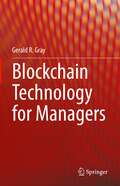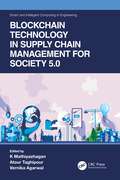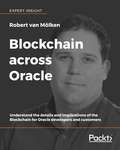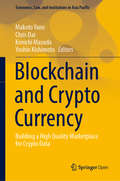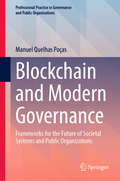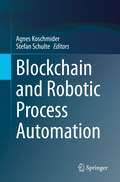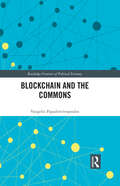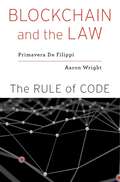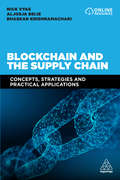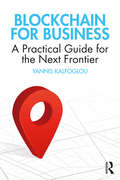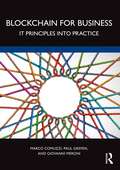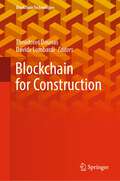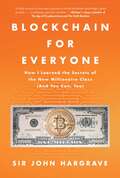- Table View
- List View
Blockchain Technology for Managers
by Gerald R. GrayBlockchain is a technology that tends to be misunderstood by managers that need to make technology acquisition decisions. This book will provide readers with a basic understanding of blockchain and distributed ledger technology (DLT), the technologies that underpin it, and the technologies DLT is built upon. The book is purposefully not a book on how to code or explore other technical aspects of blockchain (other than the fundamentals). Rather, it provides managers with the basic understanding of the architectures and consensus algorithms, how they work, the design trade-offs of each architecture type, and what problems and use cases the core characteristics of DLT are best suited to solve ─ providing business managers with the core information they need to ask the right questions of vendors when making business value assessments and acquisition decisions.
Blockchain Technology for Smart Cities (Blockchain Technologies)
by Dhananjay Singh Navin Singh RajputThis book provides a comprehensive overview of various aspects of the development of smart cities from a secure, trusted, and reliable data transmission perspective. It presents theoretical concepts and empirical studies, as well as examples of smart city programs and their capacity to create value for citizens. The contributions offer a panorama of the most important aspects of smart city evolution and implementation within various frameworks, such as healthcare, education, and transportation. Comparing current advanced applications and best practices, the book subsequently explores how smart environments and programs could help improve the quality of life in urban spaces and promote cultural and economic development.
Blockchain Technology in Project Finance: A Legal and Practical Model for Financing Mega-Investments (Routledge Open Business and Economics)
by Witold Srokosz Paweł Lenio Grzegorz SobieckiThere is currently no comprehensive scientific study that addresses the problem of financing projects using Distributed Ledger (blockchain) Technology (DLT) that are not themselves embedded in the blockchain ecosystem, particularly in the context of long-term and capital-intensive investments. This book fills this gap. It poses a number of research questions such as what financing model/mechanism is the most effective in the long term where very large financial resources are concerned; are there appropriate legal regulations in place; and can DLT (blockchain) technology provide usability and solutions that can be used in the process of financing capital-intensive investments?The book ultimately shows that it is possible to build a legal and economic model that would effectively enable the financing of long-term and capital-intensive investments, based on a specially prepared integrated platform operating on the basis of blockchain technology. As a result of the mechanisms of smart contracts, the platform would enable, the issuance and service of tokens, including equity tokens, but also auxiliary and payment or utility tokens, and the automation of relations between stakeholders. It would also allow the creation of a virtual decentralized autonomous organization (DAO) that would control the implementation of the project, and a decentralized exchange that would enable token trading.The core readership for the book is academics, scholars and researchers in the fields of economics, finance and law, particularly those focused on blockchain technology, distributed ledger systems, and innovative financing mechanisms for large-scale investments. Policymakers and regulators involved in developing policies and legal frameworks for blockchain technology, cryptocurrencies, and financial innovation would find it to be a practical reference.
Blockchain Technology in Supply Chain Management for Society 5.0 (Smart and Intelligent Computing in Engineering)
by Vernika Agarwal K Mathiyazhagan Atour TaghipourSociety 5.0 is a human-centered community where integrated systems operate throughout society to secure comfort in all aspects of life, from energy and medical care, to education, work, and leisure. Blockchain technologies enable the streamlining of supply chain processes and information sharing among various industries. This book presents recent research on the adaptation and implementation of Blockchain technologies in supply chain management in Society 5.0. It discusses different applications of blockchain, its important role in connecting information technology and artificial intelligence with human lives, the challenges, and the future of supply chain management for societal improvements.
Blockchain Tethered AI: Trackable, Traceable Artificial Intelligence and Machine Learning
by Karen Kilroy Lynn Riley Deepak BhattaRemove your doubts about AI and explore how this technology can be future-proofed using blockchain's smart contracts and tamper-evident ledgers. With this practical book, system architects, software engineers, and systems solution specialists will learn how enterprise blockchain provides permanent provenance of AI, removes the mystery, and allows you to validate AI before it's ever used. Authors Karen Kilroy, Lynn Riley, and Deepak Bhatta explain that AI's ability to change itself through program synthesis could take the technology beyond human control. With this book, you'll learn an efficient way to solve this problem by building simple blockchain controls for verifying, tracking, tracing, auditing, and even reversing AI. Blockchain tethered AI interweaves the MLOps process with blockchain so that an MLOps system requires blockchain to function, which in turn tethers AI. This guide shows you how. You will: Learn how to create and power AI marketplaces with blockchainUnderstand why and how to implement on-chain AI governanceControl AI by learning methods to tether it to blockchain networksUse blockchain crypto anchors to detect common AI hacksLearn methods for reversing tethered AI
Blockchain Transaction Data Analytics: Complex Network Approaches (Big Data Management)
by Zibin Zheng Dan Lin Jiajing WuBlockchain, a decentralized ledger technology based on cryptographic algorithms, ensures the creation of immutable and tamper-proof ledgers in decentralized systems. The transparent nature of blockchain allows public access to transaction records, providing unprecedented opportunities for blockchain data analytics and mining. The primary value of blockchain transaction data analytics lies in two aspects: 1) by delving into the details of blockchain transaction data, we can extensively explore various types of user behavior patterns and the evolutionary process of blockchain transaction networks; and 2) analyzing blockchain transaction data aids in identifying illicit activities, offering effective regulatory solutions for the establishment of a healthier blockchain ecosystem. This book focuses on data analytics based on network-based approaches, providing a comprehensive analysis of blockchain data analytics problems, key technologies, and future directions. Different from most existing book, this book takes a unique approach to blockchain data analysis research, focusing on data analytics based on network-based approaches. Leveraging network analysis methods, the book concentrates on three main aspects of blockchain transaction data analytics and mining: (1) transaction network modelling and pattern mining, including macro and micro-level account attributes, money laundering network patterns, and network evolution patterns; (2) account business classification, such as account label prediction based on graph neural networks; and (3) anomaly behavior identification, covering phishing detection, risk scoring, and transaction tracking. Designed as a valuable resource for students, researchers, engineers, and policymakers in various fields related to blockchain data analytics, this book holds significant importance for understanding blockchain transaction behavior and addressing the detection of illicit activities in the blockchain space.
Blockchain Transformations: Navigating the Decentralized Protocols Era (Signals and Communication Technology)
by Sheikh Mohammad Idrees Mariusz NowostawskiThis book provides a guide for those looking to understand the potential of blockchain technology and its impact on various industries. The book provides an in-depth exploration of blockchain technology, its use cases, and the opportunities and challenges it presents. From digital currencies and smart contracts to supply chain management and decentralized finance, the book covers all the key aspects of blockchain technology. The authors also go beyond the technical details, providing valuable insights and practical advice on how to navigate this new era of decentralization and trustless transactions. The book is an ideal read for researchers, entrepreneurs, investors, or anyone looking to stay ahead of the curve and stay informed about the future of blockchain technology.
Blockchain across Oracle: Understand the details and implications of the Blockchain for Oracle developers and customers
by Robert Van MölkenLearn what the Blockchain is, what the differences between available blockchain platforms are, how to work with Oracle’s Blockchain Cloud Service, and how Blockchain can change the direction of your Oracle work and the focus of your customers.Key FeaturesA professional orientation of the Blockchain for Oracle developers and customersLearn what the Blockchain is and how it will affect for you and your customersLearn how blockchain will disrupt traditional cross-organizational applicationsImplement your own Blockchain on Oracle and develop your first smart contract Industry directions of the Blockchain to help you decide where to develop your skillsBook DescriptionBlockchain across Oracle gives you the professional orientation to Blockchain that you need as an Oracle developer in today’s changing world. Written and prepared for you by Oracle Developer Champion Robert van Mölken, this book gets you up to speed with the details of the Blockchain - core concepts, how to implement Oracle’s Blockchain Cloud Service, industry implications for the Blockchain, and how the Blockchain will affect your Oracle customers.Robert van Mölken introduces you to the history and concepts of the Blockchain. You’ll really get to understand the Blockchain inside and out, as an Oracle developer or solution architect. You’ll understand the Blockchain flow, and how the hashes and chains create a new decentralised paradigm for you as an Oracle developer. You’ll gain insights into how the Blockchain affects Oracle developers and customers in this modern and disruptive era. You’ll see how the Blockchain concepts work in this new world where Assets, Transactions, Security, and Privacy, can all be sustained across a decentralized system for your customers.Then you'll find a detailed look at the cutting-edge Oracle middleware solutions. You’ll learn about Hyperledger Fabric, the opensource Blockchain framework used by Oracle as its core, and how to set up your own Oracle Blockchain Network. You’ll design and develop a smart contract, and learn how to run it on the Oracle Blockchain Cloud Service.The final part of the book looks at how the Blockchain will affect your customers across various industry sectors. By studying industry trends in the financial services sector, healthcare industry, and the transport industry, you’ll discover how the options and possibilities for you and your clients are being transformed by the Blockchain across Oracle. You’ll complete this professional orientation by looking at Blockchain trends and future directions.What you will learnA full introduction to the BlockchainHow the Blockchain affects Oracle developers and customersCore concepts including blocks, hashes, and chains, assets, transactions, and consensusHow to work with Oracle Cloud to implement a Blockchain NetworkDesign, develop, and run smart contracts on the Oracle Blockchain Cloud ServiceBlockchain security and privacy for Oracle developers and clientsPublic and private Blockchain decisions for Oracle architects and developersIndustry analysis across finance, governance, and healthcare sectorsIndustry trends and the future of the Blockchain technologyWho this book is forThis book is a professional orientation for all Oracle developers, solution architects, and decisions makers involved in Oracle system and future development.
Blockchain and Banking: How Technological Innovations Are Shaping the Banking Industry
by Pierluigi MartinoThis book explores blockchain technology’s impact on banks, particularly how blockchain technology can create new opportunities for banks and poses new threats to their business. The digital revolution in the banking industry, whose customers are increasingly adapting to new technologies and new types of competitors and solutions arising in the space, has had a significant impact on the banking industry over the past few years, requiring banks to substantially rethink their business models and strategies in order to cope with these developments. The rise of blockchain’s distributed ledger technology (DLT) has also played an important role since it has the potential to change the whole banking industry in faster and more disruptive ways than ever before. Born as the technology underlying Bitcoin, which has been used to allow the recording of cryptocurrencies transactions, blockchain can facilitate the process of recording any transaction type and track the movement of any asset, finding application in many different areas. Specifically, it has been acknowledged as a disruptive force in the financial sector and a key source of future financial market innovation with the potential to reshape existing business models in the financial services industry. Regarding the banking industry in particular, existing literature suggests that blockchain poses new challenges and generates opportunities as well as threats. This is pushing banks to rethink their operations, business models and strategies. However, literature in this regard is still in its infancy, and we do not yet have a clear understanding of blockchain technology’s potential implications for banks. This book expands the literature on blockchain technology in banking by providing new insights into the developments, trends and challenges of blockchain in the banking industry. In particular, sheds more light on the implications of blockchain technology for banks by discussing the advantages and disadvantages related to this technology and exploring its potential impact on traditional banking business models.
Blockchain and Crypto Currency: Building a High Quality Marketplace for Crypt Data (Economics, Law, and Institutions in Asia Pacific)
by Makoto Yano Chris Dai Kenichi Masuda Yoshio KishimotoThis open access book contributes to the creation of a cyber ecosystem supported by blockchain technology in which technology and people can coexist in harmony. Blockchains have shown that trusted records, or ledgers, of permanent data can be stored on the Internet in a decentralized manner. The decentralization of the recording process is expected to significantly economize the cost of transactions. Creating a ledger on data, a blockchain makes it possible to designate the owner of each piece of data, to trade data pieces, and to market them. This book examines the formation of markets for various types of data from the theory of market quality proposed and developed by M. Yano. Blockchains are expected to give data itself the status of a new production factor. Bringing ownership of data to the hands of data producers, blockchains can reduce the possibility of information leakage, enhance the sharing and use of IoT data, and prevent data monopoly and misuse.The industry will have a bright future as soon as better technology is developed and when a healthy infrastructure is created to support the blockchain market.
Blockchain and Distributed Ledger Technology Use Cases: Applications and Lessons Learned (Progress in IS)
by Horst Treiblmaier Trevor ClohessyBlockchain and other trustless systems have gone from being relatively obscure technologies, which were only known to a small community of computer scientists and cryptologists, to mainstream phenomena that are now considered powerful game changers for many industries. This book explores and assesses real-world use cases and case studies on blockchain and related technologies. The studies describe the respective applications and address how these technologies have been deployed, the rationale behind their application, and finally, their outcomes. The book shares a wealth of experiences and lessons learned regarding financial markets, energy, SCM, healthcare, law and compliance. Given its scope, it is chiefly intended for academics and practitioners who want to learn more about blockchain applications.
Blockchain and Modern Governance: Frameworks for the Future of Societal Systems and Public Organizations (Professional Practice in Governance and Public Organizations)
by Manuel Quelhas PoçasThis book shows how blockchain technology can transform the foundational systems of our society. Written by an industry expert with a background in political science, international relations, law, management, and technology, the book merges social, political, economic, and legal theories with technological expertise to present a groundbreaking framework for using blockchain in governance and public organizations. Imagine a country as a digital space where humans and resources interact seamlessly. This book explores such possibilities, illustrating how blockchain can redefine governance beyond physical borders. Addressing the urgent need for adaptive solutions in a globally interconnected world, the author provides a strategic roadmap for implementing blockchain in public governance. With clear explanations, real-world examples, and practical applications, this book will inspire and guide professionals and policy-makers seeking to utilize blockchain technology for innovative governance solutions.
Blockchain and Other Emerging Technologies for Digital Business Strategies (Advanced Sciences and Technologies for Security Applications)
by Hamid Jahankhani Stefan Kendzierskyj David V. KilpinThis book aims to explore the aspects of strategic leadership in a digital context together with the cyber-physical relationships whilst performing business activities. Furthermore, this book looks to investigate the interactions from both the organization strategy including the cross-functional actors/stakeholders whom are operating within the organization and the various characteristics of operating in a cyber secure ecosystem. The book provides a valuable reference for IT directors, strategic leaders, cybersecurity experts, network security professionals. It is also aimed at researchers seeking to obtain a more profound knowledge of machine learning and deep learning in the context of cybersecurity. Furthermore, the book is an exceptional advanced text for Ph.D. and master’s degree programs in cybersecurity, network security and computer science. Each chapter is written by an internationally renowned expert who has extensive experience in law enforcement, industry or academia. Furthermore, this book blends advanced research findings with practice-based methods to provide the reader with advanced understanding and relevant skills.
Blockchain and Robotic Process Automation
by Stefan Schulte Agnes KoschmiderThis book integrates the material of the lecture series “Blockchain and Robotic Process Automation”, offered at Kiel University. The lecture series sheds light on current research topics on blockchain and robotic process automation (RPA) also in combination with business process management (BPM) or process mining. In this series, leading scientists and business experts give insights into the use of the blockchain technology and RPA. The seven contributions included offer a general introduction into blockchain and smart contracts, and detail the extraction of meaningful events for process mining from blockchain, challenges of blockchain-based collaborative business processes, executing Decision Model and Notation decisions on the blockchain, a blockchain-based solution for digital payment, blockchain use cases in transportation and logistics, and automatically identifying process automation candidates using natural language processing. Overall, the book provides researchers and graduate students with a basic introduction into blockchain, its applications, useful combinations of BPM and blockchain, and use cases for RPA.
Blockchain and Supply Chain Logistics: Evolutionary Case Studies
by Atanu Chaudhuri Nachiappan Subramanian Yaşanur KayıkcıThis book introduces blockchain technology applications in supply chains. Blockchain is a relatively new tool, nevertheless, there have been considerable advances over the last five years, and blockchain is now poised to revolutionize the conventional supply chains with the offering of accountability and quality to the wider complex supply networks. Based on literature reviews and original research, this book serves as an essential introduction to blockchain and its applications in supply chain. The unique features of the book are empirical studies to demonstrate the application of blockchain technology in food, healthcare, manufacturing, transportation and retail sectors. Each chapter includes research framework and open research questions. Simple narration of concept and detailed insights from primary research information. Use case narrative will provoke the readers to demystify the myths in application of concepts in the supply chain . Overall, the book demystifies blockchain technology, reviews evolution and outlines its future applications by blending contents to meet the expectations of both academic and practice community.
Blockchain and Web3: Building the Cryptocurrency, Privacy, and Security Foundations of the Metaverse
by Winston Ma Ken HuangAn in-depth and authoritative treatment of one of the most pressing topics of our time In Blockchain and Web3: Building the Cryptocurrency, Privacy, and Security Foundations of the Metaverse, two tech and finance experts deliver a comprehensive and accessible guide to the present and future of blockchain technology and how it will form the foundation of a new, better internet. To support a concept as bold as the Metaverse, we need several orders of magnitude more powerful computing capability, accessible at much lower latencies, across a multitude of devices and screens. You&’ll discover how blockchain can accelerate data flow, exchange, and transactions to create and transfer value around the world and, at the same time, how it can be used to protect user data privacy and security with decentralized web infrastructures. The book also includes: Discussions of how sovereign governments are entering the blockchain fray and how their entry, especially with CBDC digital currency, shapes the conversations around Web3 Explorations of whether we will ever realize the holy grail of blockchain tech: interoperability to compete with Big Tech platformsDiscussion of new security and privacy issues rising from the intersection of Blockchain, Web3 and Metaverse.A fascinating and eye-opening treatment of the past, present, and future of blockchain and the role it will play on the internet and metaverse, Blockchain and Web3 is a truly original and engaging discussion of a timely and critical topic.
Blockchain and the Commons (Routledge Frontiers of Political Economy)
by Vangelis PapadimitropoulosRecent years have seen a surge of interest in ‘the commons’ based on a simple yet radical idea: great improvements in production and management could be achieved by reducing barriers to knowledge exchange and power-sharing. Ranging from meadows, forests and parks to language, open source software (FLOSS and Blockchain) and 3D printers, the commons are distributed or common property resources/infrastructures which are self-managed by their user communities. While acknowledging the significant contributions that can be made through commons-based peer production, this book provides a critical examination of the commons with the aim of contributing to their long-term sustainability. In particular, the book examines the relation of Blockchain to the commons by illustrating the case study of the Commons Stack. Drawing on a range of interdisciplinary ideas and methodologies, the chapters argue that there are a number of economic and social barriers which are obstructing the wider reproduction of the commons. Problems with access to capital and training, the lack of entrepreneurial and managerial skills, and the absence of institutional support from governments, larger coops, and NGOs, are some of the external problems facing the commons today. Meanwhile, localism, gated communities, vested interests, atavism, traditionalism, ideology, conflict, neo-conservatism and techno-elitism represent some of the internal contradictions inherent in the commons. Through overcoming these contradictions, the ultimate goal is to transform capitalism into the postcapitalism of the commons: the creation of a social economy self-organised around the commons. This book provides vital reading for anyone interested in the commons from economics, techno-politics and across the social sciences.
Blockchain and the Law: Dogmatics and Dynamics (Information Technology and Law Series #37)
by Martinho Lucas Pires Francisco Pereira Coutinho Bernardo Correia BarradasThis book discusses the dogmatic (that what is settled) and the dynamic (that what is changing) aspects of the relationship between blockchain and the law from a critical perspective. With contributions from legal and financial experts involved in both academy and business from Europe, Africa and North and South America, the book looks at the abstract complexities and practical challenges of regulating blockchain technology and its developments, such as crypto assets and smart contracts, from the perspectives of financial, tax, civil, and international law. Moreover, the book also delves into some exciting and cutting-edge related topics such as blockchain applications for litigation, CBDC and elections.The volume offers insightful considerations that will be helpful for legal practitioners involved in the crypto and Distributed Ledger Technology (DLT) phenomenon.Francisco Pereira Coutinho is Associate Professor at the Nova School of Law in Lisbon, Portugal.Martinho Lucas Pires is Teaching Assistant in the Department of Law of the Universidade Católica Portuguesa in Lisbon, Portugal.Bernardo Correia Barradas is a Lawyer and Senior Legal Advisor in payments in Washington DC, United States.
Blockchain and the Law: The Rule of Code
by Primavera De De FilippiSince Bitcoin appeared in 2009, the digital currency has been hailed as an Internet marvel and decried as the preferred transaction vehicle for all manner of criminals. It has left nearly everyone without a computer science degree confused: Just how do you “mine” money from ones and zeros? The answer lies in a technology called blockchain, which can be used for much more than Bitcoin. A general-purpose tool for creating secure, decentralized, peer-to-peer applications, blockchain technology has been compared to the Internet itself in both form and impact. Some have said this tool may change society as we know it. Blockchains are being used to create autonomous computer programs known as “smart contracts,” to expedite payments, to create financial instruments, to organize the exchange of data and information, and to facilitate interactions between humans and machines. The technology could affect governance itself, by supporting new organizational structures that promote more democratic and participatory decision making. Primavera De Filippi and Aaron Wright acknowledge this potential and urge the law to catch up. That is because disintermediation—a blockchain’s greatest asset—subverts critical regulation. By cutting out middlemen, such as large online operators and multinational corporations, blockchains run the risk of undermining the capacity of governmental authorities to supervise activities in banking, commerce, law, and other vital areas. De Filippi and Wright welcome the new possibilities inherent in blockchains. But as Blockchain and the Law makes clear, the technology cannot be harnessed productively without new rules and new approaches to legal thinking.
Blockchain and the Supply Chain: Concepts, Strategies and Practical Applications
by Bhaskar Krishnamachari Nick Vyas Aljosja BeijeBlockchain can transform companies, if it is successfully integrated into existing supply chain ecosystems and practices. Some of the key benefits are dispute resolution, foolproof track and trace, event management, operational as well as financial transparency, speed to market, visibility, elimination of heavy reliance on intermediary, integration of IoT technology, machine learning, and artificial intelligence. Blockchain and the Supply Chain highlights how blockchain can enable opportunities within the end-to-end supply chain.The team of authors look at the evolution of the network, systems and finance, as well as basics of blockchain such as peer-to-peer transactions, consensus based algorithms and smart contracts. They include cases which highlight the opportunities within the different nodes of systems, sales and operations planning and provide practical examples from specific supply chains, such as the movement of temperature controlled goods, dry goods and precious commodities, as well as general cargo flow. Blockchain and the Supply Chain examines the business case for blockchain, including increased efficiency of transactions. It also covers the broader set of technologies relevant to supply chain, such as IoT, Big Data and Cyber Security basics and the capabilities they offer.
Blockchain and the Supply Chain: Concepts, Strategies and Practical Applications
by Bhaskar Krishnamachari Nick Vyas Aljosja BeijeBlockchain is a transformative driver for change in all industries. Learn from the latest research and case studies how this technology can and will be used to revolutionize supply chain management.Blockchain and the Supply Chain provides a complete overview of blockchain and the key benefits of integrating this technology into the supply chain. This textbook explains how track and trace can be improved, transaction efficiency increased, visibility enhanced, and more through blockchain. With extensive case studies, learning is underpinned by practical insights as well as cutting-edge research. Clear and accessible information is provided to students on how blockchain will affect supply chain processes, metrics and performance and how to capitalize on the potential of this technology.The fully revised new edition includes the latest information on Enterprise Blockchain, Ethereum and Hyperledger. Focus is also placed on the application of Cloud, Internet of Things (IoT), Machine learning (ML) and other technologies that support supply chains and their integration with blockchain. This textbook highlights how to use blockchain as an enabler and key driver for solutions in the end-to-end supply chain. Online resources include lecture slides and example assignments and quizzes.
Blockchain for Business: A Practical Guide for the Next Frontier
by Yannis KalfoglouThis book sets out to explain blockchain for the non-technical expert, to decipher the dense technicalities that dominate the field and to present the opportunities for busy professionals using practical applications and case studies. Presented in a clear and structured way and with documented real-world cases, the book is a practical reference guide that can be used across different industries. It offers both a constructive and critical review of the pain points blockchain is facing today, illustrates the pitfalls as well as the opportunities for business and describes the steps towards overcoming them. It also aims to provide a unique view of both the intersection and synergy of blockchain with other emerging technologies and the wider digital ecosystem, as we see increasingly that blockchain alone won’t be able to deliver business solutions. Most important, the book identifies trends and a path for the future of blockchain and its impact on society as a whole. The book is written for business audiences across all sectors. It is not a technical guide to blockchain, but it enables businesspeople to be better informed and prepared to plan ahead and develop strategies using blockchain.
Blockchain for Business: IT Principles into Practice
by Paul Grefen Giovanni Meroni Marco ComuzziThis book discusses the up-and-coming blockchain technology in a structured way from the conceptual, technological, and business perspectives, thereby providing the integrated insight that is essential for truly understanding blockchain applications and their impact. While most people may know about blockchain from Bitcoin and news about its price in the financial markets, blockchain is a technology that increasingly permeates the way in which modern businesses operate. However, its dynamics and functioning remain obscure for most people. This book gives readers the tools to understand the full extent to which blockchain technology is or can be used in business. First, the book focuses on the functioning of blockchain systems, introducing basic concepts such as transactions, consensus mechanisms, and smart contracts, as well as giving a smooth introduction to the basic features of cryptography that underpin blockchain technology, e.g., digital signatures and hashing. Then, the book focuses on specific blockchain platforms (Bitcoin, Ethereum, private blockchain platforms) currently used for the implementation of cryptocurrencies and other blockchain systems. Finally, it introduces a set of tools to understand and analyze the suitability of blockchain technology in different business scenarios from the business model, and business operation perspectives. Examples and case studies of blockchain applications currently in production are discussed extensively across the book. This book targets students and educators with an interest in blockchain technology providing a one-stop shop to obtain a deep and complete insight in blockchain technology and its applicability in different business scenarios. The textbook is designed primarily for third and fourth year undergraduate students in industrial engineering, business and management, and information systems. However, it can be adopted also in the computer science majors, since it does not strictly require any specific pre-requisite knowledge. At the graduate level, this book can be used in courses for industrial engineering, information systems, and management students. Finally, the book is also of interest to practitioners, like business analysts, process analysts, and information system architects, to understand the enabling and transformative potential of blockchain in a given business scenario.
Blockchain for Construction (Blockchain Technologies)
by Theodoros Dounas Davide LombardiThis book highlights the design, use and structure of blockchain systems and decentralized ledger technologies (B/DLT) for use in the construction industry. Construction remains a fragmented change-resistant industry with chronic problems of underproductivity and a very low digitization factor compared to other fields. In parallel, the convergence, embedding and coordination of digital technologies in the physical world provides a unique opportunity for the construction industry to leap ahead and adopt fourth industrial revolution technologies. Within this context, B/DLT are an excellent fit for the digitization of the construction industry. B/DLT are effective in this as they organize and align digital and physical supply chains, produce stigmergic coordination out of decentralization, enable the governance of complex projects for multiple stakeholders, while enabling the creation of a new class of business models and legal instruments for construction.
Blockchain for Everyone: How I Learned the Secrets of the New Millionaire Class (And You Can, Too)
by Sir John HargraveFrom the author of Mind Hacking and founder of Bitcoin Market Journal comes the first book to explain the money-making secrets behind bitcoin and blockchain in a user-friendly format. When John Hargrave first invested in cryptocurrency, the price of a single bitcoin was about $125; a few years later, that same bitcoin was worth $20,000. He wasn’t alone: this flood of new money is like the early days of the Internet, creating a new breed of “blockchain billionaires.” Sir John has unlocked their secrets. In Blockchain for Everyone, Sir John reveals the formula for investing in bitcoin and blockchain, using real-life stories, easy-to-understand examples, and a healthy helping of humor. Packed with illustrations, Blockchain for Everyone explains how (and when) to buy bitcoin, cryptocurrencies, and other blockchain assets, with step-by-step instructions. Blockchain for Everyone is the first blockchain investing book written for the layperson: a guide that helps everyone understand how to build wealth wisely. It’s the new investing manifesto!
